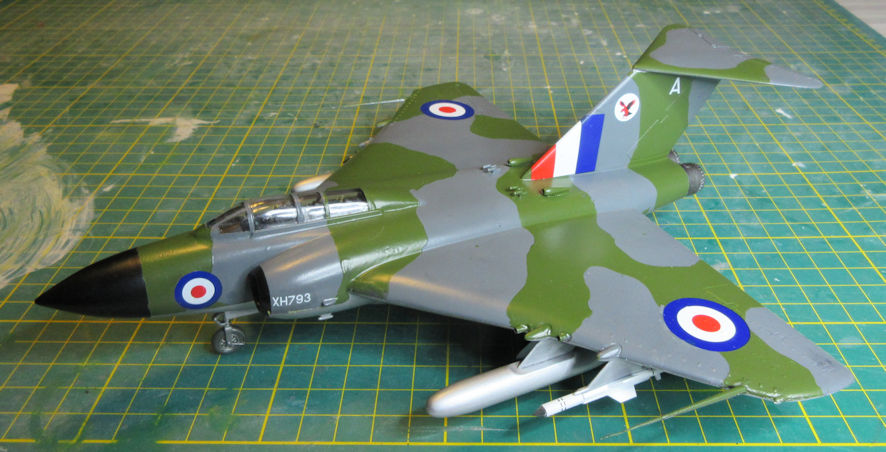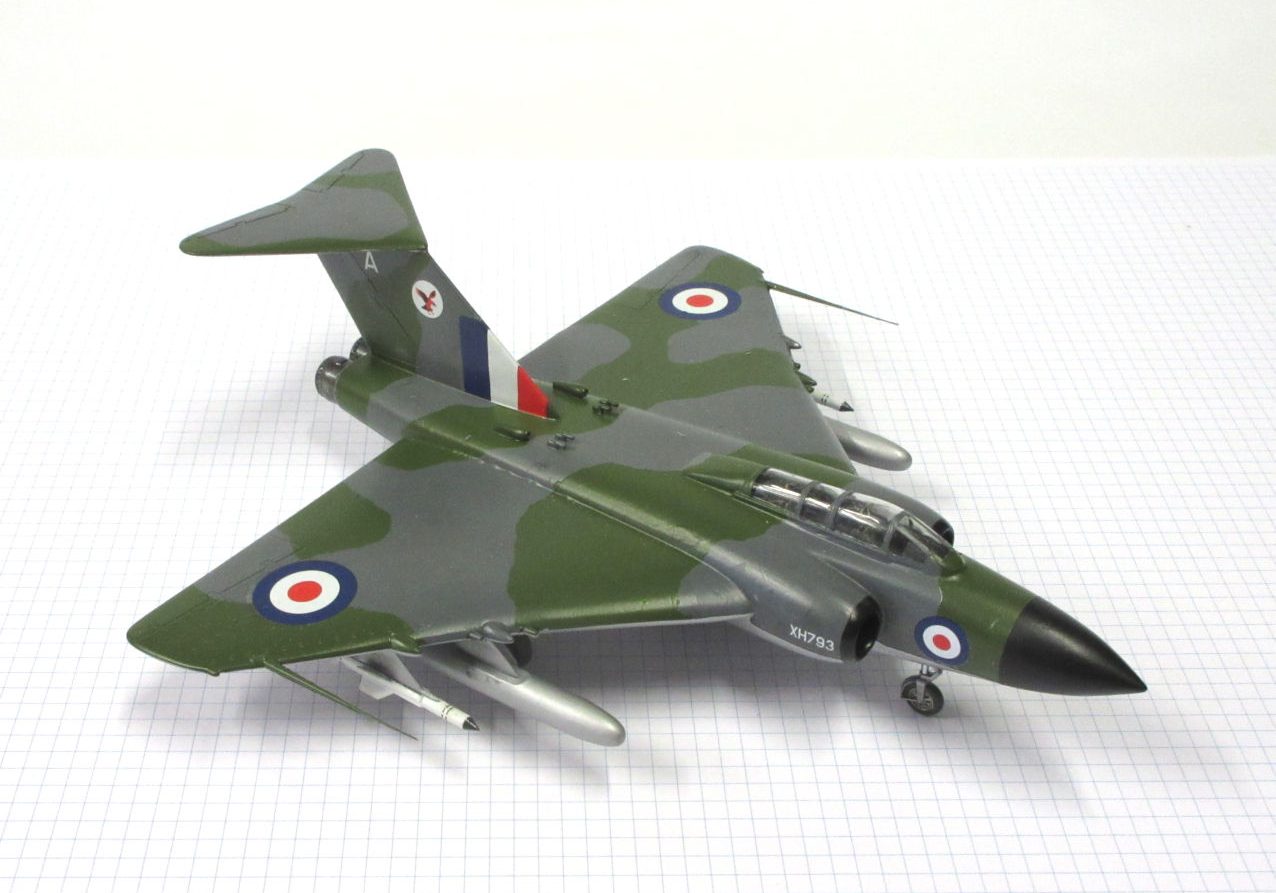We’re all allowed to have our biases and to be truthful about it: I never liked the look of the Gloster Javelin very much. It was a big fat aeroplane with big fat wings that looked about as capable of doing anything useful in a military sense as a loaf of bread. I was wrong, it was a useful night and all-weather interceptor that did the job it was designed to do well and remained in service for over a decade. The Royal Air Force took delivery of over 400 of them and they flew with almost twenty squadrons over the life of the aircraft. What makes them look old and slow, to me anyhow, is that they are more or less contemporary with the sleek and purposeful English Electric Lightning which entered service only a few years after the Javelin, could fly twice as fast and, most important to me, looked like a fighter while the Javelin did not. So why make a model of one?
As far as I can tell there are only two relatively satisfactory kits of the Javelin in 1/72 scale. One of a Javelin FAW.9 released by Frog in 1975 that has subsequently been reboxed in the east by Novo and Progress. The other is also a Javelin FAW.9 but it began as a Javelin T.3 released by Heller in 1981 and was rereleased by Airfix with parts to make a FAW.9 in 1994. I have the original Heller Javelin T.3 and haven’t had much interest in making it because I think it looks even sillier than the Javelin FAW.9. The Frog kit comes with the additional part to make the FAW.9R with a long refueling probe, but when it comes to ungainliness one has to draw the line somewhere.
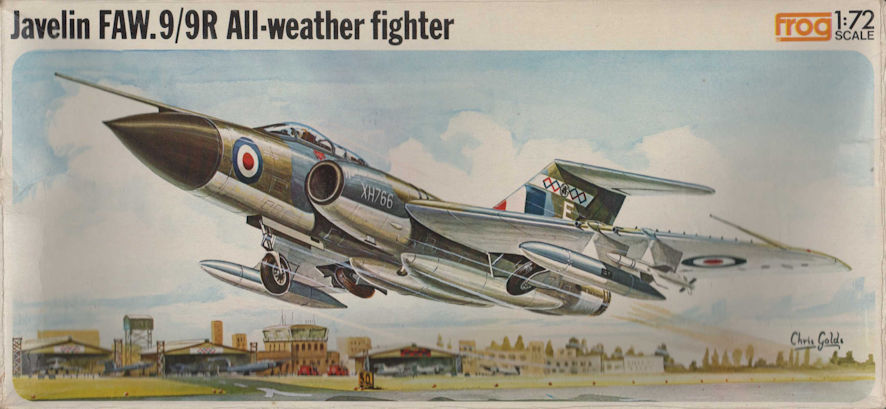
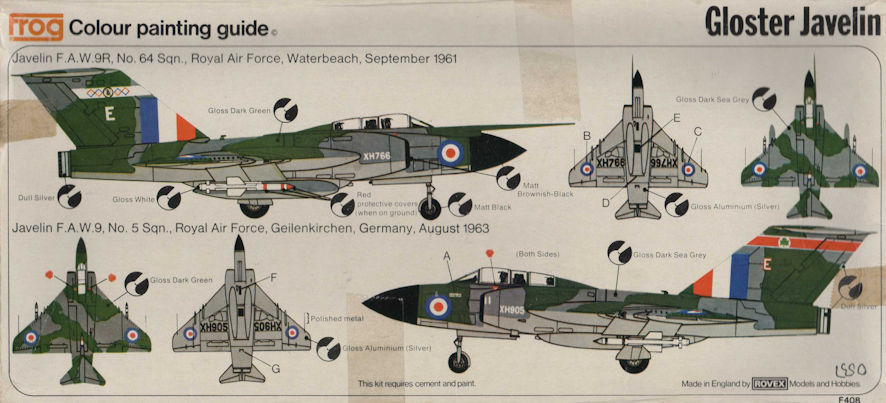
When Frog released their Javelin kit in 1975 it was the latest and best in scale models. More or less accurate with details including ejector seats, underwing tanks and missiles and optional markings for two aircraft. True, it had raised panel lines but in 1975 almost all kits had raised panel lines and almost nobody thought it necessary to remove them and rescribe the panels.
I can’t recall being very interested in rushing out to buy this kit, it was a Javelin after all, but Frog went out of business in the mid 1970s and it’s final kits were produced in 1976. Hearing of this in about 1977 I went down to my local newsagency (remember when ordinary shops sold model kits) and bought up as many Frog kits as it was possible for me to fit into my shopping trolley, fearing that I would never see them again. (Little did I know that most of the Frog moulds would end up in Russia and some would eventually be re-released by Revell.)
Thinking back on it now, that shopping trolley of Frog kits was probably the beginning of my Treasure which now extends to over a thousand unmade kits. Like all the kits I now have, I intended to make those Frog kits and did make some of them in the following few years. The rest became part of my slowing growing Treasure trove. I still have some of them but as newer and better kits became available I gradually replaced them so I now have left only ten Frog kits in my collection and nine models made from Frog kits. The reason I still have the Frog Javelin kit is, because, apart from the slightly more recent Airfix kit, there has been nothing better offered to replace it.
Flashing forward to 2020, everyone who shops on-line from BNA will know that if your order exceeds $150 postage is then free. This is a clever ploy which encourages us to spend more than we intended to, and I am one who has fallen for their clever plan. Among the things I’ve been using to boost my total to over $150 is the AK Real Color sets of lacquer paints. One that I bought was the set for 1950s RAF aircraft and when it arrived I thought I should do something about using it. The RAF flew some lovely looking aircraft in the 1950s such as the Hawker Hunter and the Supermarine Swift. Going out to search through my Treasure I found the Swift but not the Hunter. (It’s in there somewhere, I hope.) Looking around in desperation the next RAF 1950s fighter kit I laid my eyes on was the Frog Javelin. I hesitated, I almost pulled my hand back and looked for the Hunter again, but then I resolved that perhaps it would not hurt to see what these old Frog kits are actually like to make in the twenty-first century.
Before proceeding, let me give you the summary of what I found. It is not a bad kit, really, by twentieth century standards, but the only kind of kit that is less joy to make would be a 1960s Airfix kit.
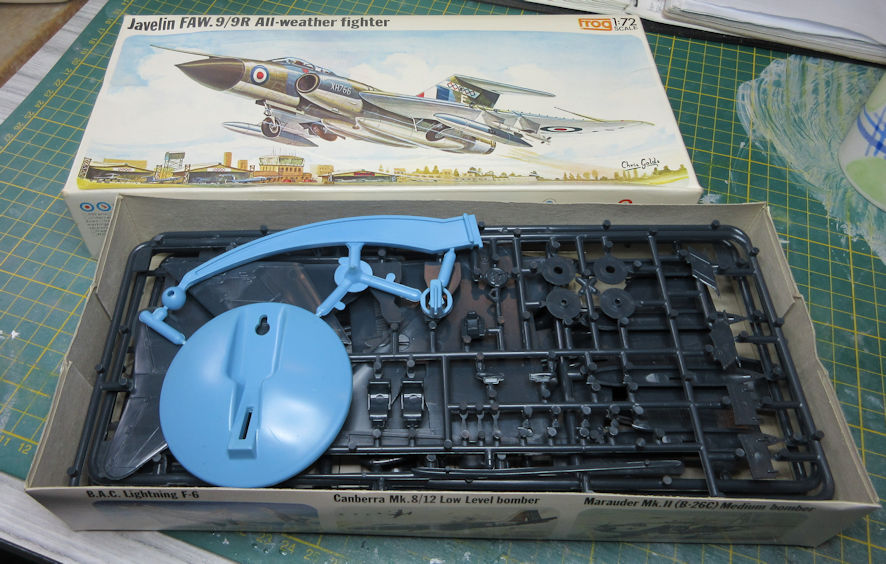
There is nothing fragile or fiddly about this kit, it is good honest British workmanship. The undercarriage is thick and strong, the parts are thick and rugged and putting it together is not really difficult. Perhaps the ejector seats would have been acceptable in 1975 but they look like a cubist interpretation of the real thing and had to be replaced. The prominent pitot tubes on both wings were over scale and droopy so they also had to be replaced. The decals might have been useable after forty-five years but I wasn’t prepared to risk it so they also went. A few hours searching the interweb found me some new ejector seats (not strictly for a Javelin but Martin Baker Mark 3s from the same period), new pitot tubes and new decals. A new cockpit and undercarriage would have been nice too, but I couldn’t find them so I had to deal with what the kit provided.
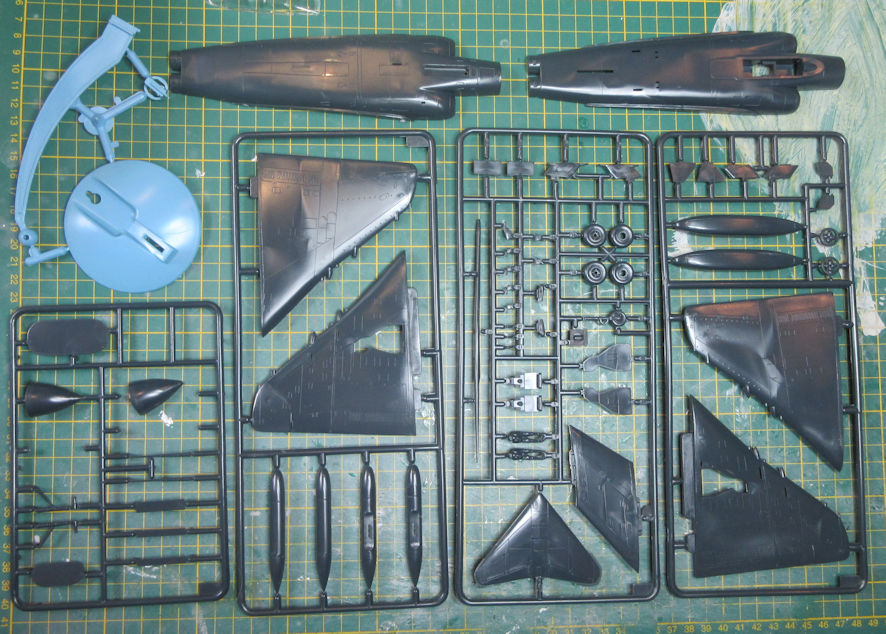
Finding some decent photos of Javelin FAW.9s was a great help. I was suspicious of photos of restored Javelins and hunted the interweb for photos of ones in service. From them I learned several things, one of the most important was about the bumps on the leading edges of the wings. It appears that there are big half-melon shaped lumps which serve a purpose I could not discern and two or four smaller protuberances which are probably gun ports for the Aden cannons. I couldn’t do much about the bigger lumps but had to replace the smaller ones with plastic rod drilled out to create some semblance of the gun ports. The afterburners at the rear of the model are not much better moulded and I might have replaced them too if there had been anything available to do it. I’m not so good a modeller as to be able to replicate that kind of complexity on a cylinder, so they stayed.
The real challenge was in getting rid of all the raised panel lines. I not masochistic enough to replace the raised lines and then rescribe the entire model and I couldn’t see any reason why I would want to. From what I could see from photos Javelin’s had few visible panel lines and they were very well maintained so panel lines would not have been appropriate for weathering the model. In any case, I have a few things that I refuse to do as a modeller and that includes panel line scribing and weathering. Life is too short!
Removing the panel lines usually requires nothing more than a vigorous attack on the model with some medium grit wet-and-dry sandpaper. I had to restrain myself this time, however, because Frog has gone to the trouble of covering the tops of the wings with lots of little vortex generators which were not very prominent but needed to be preserved. The solution was to cover them with little strips of masking tape while sanding away the rest of the detail. I was tempted to rescribe the speed brakes but decided that you really can’t see them on the photographs of the real aeroplane, so why bother with this model.
There were some health gaps between wings and fuselage and other parts. The air intakes also needed attention to extend them further back into the model. After a few cycles with the filler and primer the model didn’t look too bad. True, those big fat wings looked a little unsatisfactory without anything to break up the flat surfaces but I consoled myself by seeing that the real Javelins also looked a bit uninteresting that way. The vortex generators also looked a bit stumpy, but I can only imagine what replacing them with small slivers of plasticard would be like in my nightmares.
You’d think that after this my troubles would be over. That AK Real Color paint sure is nice to airbrush, with a little thinner, so the top grey and camouflage was almost a pleasure to apply. Strangely, the underside colour you get in the Real Color box is azure blue rather than the High Speed Silver that was common to a great many RAF aircraft in the 1950s. Fortunately I happened to be listening to a live stream about modelling in which mention was made that the Tamiya Silver (LP11) is a good interpretation of High Speed Silver, and they were right, once again with a little thinner. I didn’t want any clear lacquer to spoil the metallic sheen of the underside silver so I decaled and sealed the top before airbrushing the bottom. This was not as simple as it sounds because the decal register was off by not quite a millimeter so there was a nice bright white crescent around the roundel decals which has to be dealt with. Of my poor shaking hands, but I more or less managed it.
I almost never attach underwing stores to my models. Some people say it is because of laziness but I claim it is because they spoil the look of the aeroplane and distract from its attractive lines. But that is exactly what I wanted to do with the Javelin, distract the viewer from the Javelin’s uninteresting and ungainly shape. The drop tanks came from the kit but the Firestreak missiles were almost too dreadful to contemplate, so I replaced them with a couple left over from a Trumpeter BAC Lightning kit. I was happy with the final model but it’s not something I’d do again for fun.
